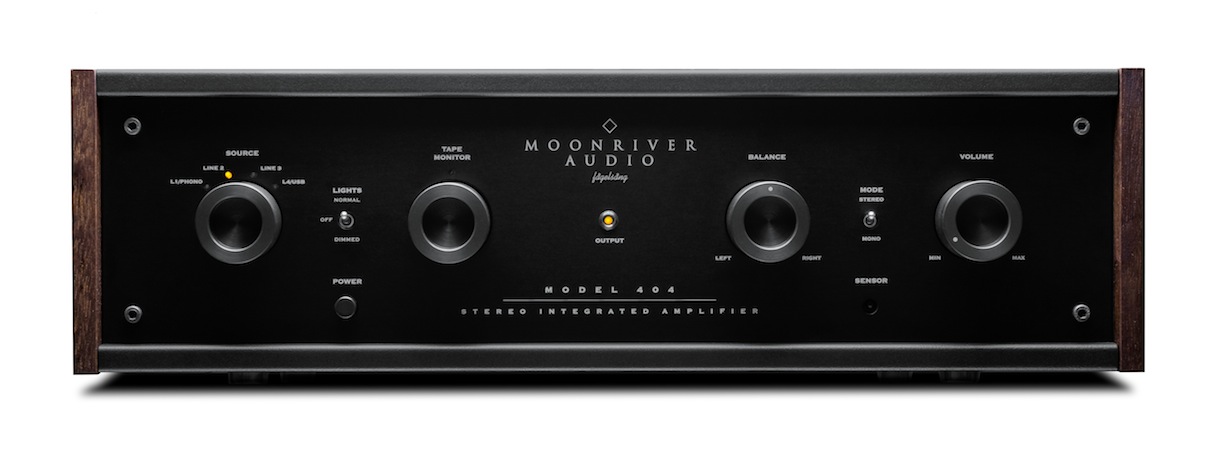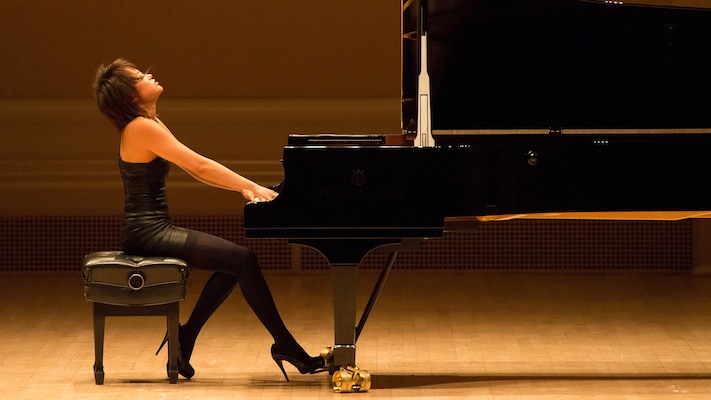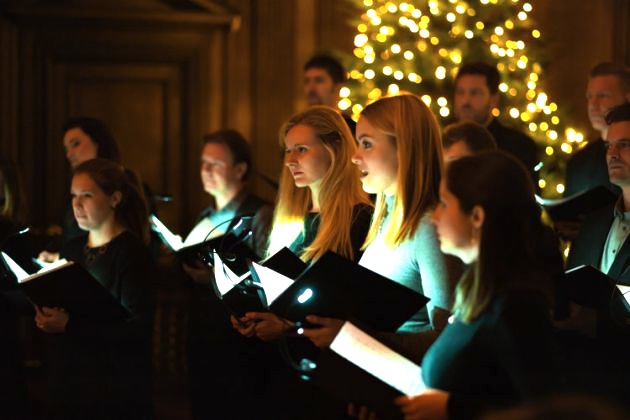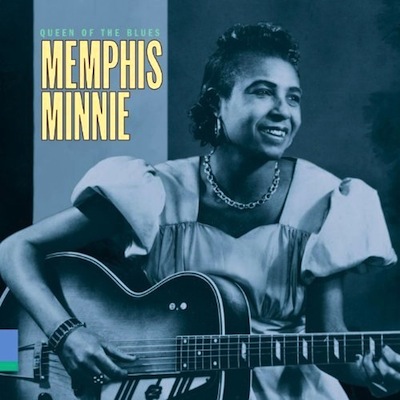
Category: Greatest Hits!
Moonriver Audio Model 404 Stereo Integrated Amplifier

The Moonriver Audio Model 404 is a solid-state stereo integrated amplifier with a rated output of 50 Watts per channel. The Model 404 combines a preamplifier stage that consists entirely of discrete devices (and therefore, there are no integrated-circuit chips in the preamplifier), and a power-amplifier stage that is Class A/B linear (and therefore, the Model 404 is not a Class-D digital-switching amplifier).
The company name of Swedish high-end-audio newcomer “Moonriver Audio” is a tribute to the song “Moon River,” from the Audrey Hepburn (1929-1993) film Breakfast at Tiffany’s. “Moon River” won for Henry Mancini (music) and Johnny Mercer (lyrics), the 1962 Academy Award (“Oscar”) for “Best Original Song.” (The screenplay was based on a novella by Truman Capote. He cried all the way to the bank.)
Therefore, the first important point is: the Moonriver 404 is hand-built in Sweden, apparently by someone who has fond memories of Audrey Hepburn.
(And so, therefore, the Moonriver 404 is not built in China by people who—most likely—do not have fond memories of Audrey Hepburn.)
The second important point is that the Moonriver 404 (US MSRP $3500; but there are optional modules) is a tremendously serious audio product. As far as I can tell, the Moonriver 404’s only “flaw” is that it never calls attention to itself. However, that’s because it only calls attention to the music.
More on what I mean by “a tremendously serious audio product,” after the jump. And more about Audrey Hepburn!
Continue Reading →
How China Made the Piano Its Own
 Yuja Wang, courtesy of Medici TV
Yuja Wang, courtesy of Medici TV
This is a first—I can’t ever remember reading an article in The Economist that brought tears to my eyes… . The article in question is, to use academic terminology, a “reception history” of the piano in Chinese culture from the mid-19th century to the present. Here’s the vignette from China’s 1966-1976 “Cultural Revolution” that brought out my handkerchief:
Lu Hong’en, the conductor of the Shanghai Symphony, was thrown into a cell. He continued to hum Beethoven there. After he tore up a copy of Mao’s “Little Red Book,” he was sentenced to death. Lu told a fellow prisoner: “If you get out of here alive, would you do two things? Find my son, and visit Austria, the home of music. Go to Beethoven’s tomb and lay a bouquet of flowers. Tell him that his Chinese disciple was humming the Missa Solemnis as he went to his execution.” Lu was shot within days. His cellmate reached the Viennese grave three decades later.
You will have to read the rest of the article for yourself, here (you probably will have to register to read five free articles a month). I consider this article to be required reading for cultural literacy in classical music in today’s world. The author or authors point out that China is not only turning out star performers (such as Yuja Wang, pictured above); the creation in China of music for the piano has reached critical mass.
The one caveat or clarification I want to offer is that the article states, without elaboration, that the state-run piano company Pearl River (the world’s largest producer) “builds for Steinway.” That statement is, in my opinion, accurate; but also, potentially very misleading. Pearl River does not make Steinway pianos, or even parts or components for Steinway pianos.
What is going on here is that the Steinway company wants its dealers also to be able to offer pianos that are more affordable. Pianos with, if perhaps not Steinway’s imprimatur, at least their nihil obstat. Those brands are the “Boston” and “Essex” pianos. The Essex pianos are “designed by Steinway” and sold by Steinway, but manufactured in China by Pearl River.
The linked-to article also includes an embedded playlist of relevant music and performances, which in and of itself is a reason to click through.
# # #
Christmas Music (Part 4): ORA Singers: “The Mystery of Christmas”

ORA Singers: The Mystery of Christmas
Music of Allain, Anonymous, Byrd, Hall, Hyde, Lauridsen, Macmillan,
McDowall, Peacock, Rowarth, Rutter, Samitz, Sixten, Tallis, Williams, and Weir.
CD Harmonia Mundi HMM 905303
Downloads (24-bit/96kHz stereo AIFF, ALAC, FLAC, and WAV) available from HDTracks.
Streaming available from Tidal.
Recorded at St. Augustine’s Church, Kilburn, London, January 23-28 and August 7-12, 2017. Nicholas Parker (all tracks except track 5) and Tim Handley (track 5 only), producers; Mike Hatch, engineer. Support for the arts from the Pureland Foundation. Total time 76’37.
My previous Christmas-music recommendations can be found here: Part 1; Part 2; and Part 3.
Here’s a fantastic new recording from a group new to me, Suzi Digby’s ORA Singers. They are as good as any handpicked professional choral ensemble out there. (I have heard most of the top ones live.) This collection showcases ORA’s “Unique Selling Proposition,” which is to prove that today, we are in a Golden Age not only of choral singing, but also of composing works for vocal ensembles. (Funny; I have long said the exact same thing about the art of the string quartet. We live in a golden age of the string quartet—both for playing and for new works.)
Therefore, ORA’s (for lack of a better phrase) business plan is to commission 100 new works for chorus over the course of ten years. (They are well on their way to achieving that goal, having commissioned 40 works in three years.) To make it even more interesting, Ms. Digby’s approach is to ask today’s composers to create works that are personal reflections upon the choral glories of the past, especially the masterworks of the Renaissance. Ambitious, yes. But several of the new works on this disc should find their ways into the standard repertory fairly quickly.
As a producer of classical recordings, one of my favorite Shibboleths (or, rubrics or axioms) long has been that, once your CD has started playing in the CD player of the reviewer, radio programmer, or record-store buyer, you have only ten seconds to make the sale. Furthermore, I believe that you make the sale only by giving the listener that “You are in good hands with Allstate” feeling. If the listener gets the feeling that your performance is for you a nerve-racking tightrope walk, no sale. (Obviously, there are exceptions to my little rule. Not much at all happens in the first ten seconds of Mahler’s Symphony 1; at least, not much by which you can distinguish a great performance from one that is merely unobjectionable.) In the case of the ORA Singers’ The Mystery of Christmas, convincing me took only the first four to eight seconds of the first track.
More information, a performance video, and sound bytes from The Mystery of Christmas after the jump. Continue Reading →
Q & A with Aaron Diehl

Aaron Diehl’s 2013 CD The Bespoke Man’s Narrative, his début on Mack Avenue Records, fell like a thunderclap upon the jazz landscape, reaching No. 1 on the JazzWeek Jazz Chart.
Something about the advance publicity must have caught my eye or ear, because I asked for a pre-release press copy of the CD. Upon playing it, I was so gobsmacked that I asked my friend and colleague Steve Martorella to come over to listen to it. Steve was a protégé of Leonard Bernstein’s, and his principal piano teacher was Murray Perahia, so I think that it is fair to say that Steve probably knows a little about piano playing. While he was listening to the climax of Diehl’s piano-trio version of “Bess, You Is My Woman Now,” Steve was definitely getting tears in his eyes. His comment: “I didn’t know that there was anyone new who could play like that.”
In due course my comments on The Bespoke Man’s Narrative appeared in Stereophile magazine. Since then, Aaron Diehl has released another small-group recording as well as a solo project. Next weekend (October 19 and 20) he will appear with the Rhode Island Philharmonic (under the direction of Bramwell Tovey) playing Gershwin’s Rhapsody in Blue. Mr. Diehl graciously agreed to answer a few questions.
Questions, answers, and a sound sample can be found after the jump. Continue Reading →
Kansas Joe McCoy and Memphis Minnie: “When the Levee Breaks” (1929)

The infosphere is fairly crackling with the news that the current incarnation of the musical ensemble Fairport Convention Fleetwood Mac has notified one of its elderly members that his services will not be required for their upcoming world tour. More than 40 years later, Fleetwood Mac Drama still grabs headlines.
My favorite story about Fleetwood Mac is that during the Narcissistically tumultuous (my words, not theirs) recording of their 1977 mega-album Rumours, the two remaining founding members of the band (Mick Fleetwood and John McVie) repaired to the recording studio’s parking lot to get a breath of fresh air. One of these two gentlemen, not at all at peace with the way things were then developing (at the time, the tattered remnants of the original band were being either re-energized or supplanted by a pair of newcomers), said (or perhaps it is more accurate to write, “whined”) to the other,
“You know, we used to be a blues band.”
To which the other replied, “Yeah. But now, we’re rich.”
(That riposte refers to the fact that while the group was recording Rumours, their most-recently-released recording Fleetwood Mac, which was the first album with newcomers Lindsey Buckingham and Stevie Nicks, was topping the charts and already throwing off so much cash that the previously hardscrabble members of the band were buying houses in Los Angeles. But: A blues record, Fleetwood Mac was not.)
That exchange says a lot about the endgame of British popular music’s fascination with American blues music.
Intriguing history, and sound bytes, after the jump link. Continue Reading →
Stile Antico: De Victoria, Tenebrae Responsories for Holy Week

Stile Antico:
Tomás Luis de Victoria, Tenebrae Responsories for Holy Week
CD Harmonia Mundi HMM 902272
Downloads (24-bit/88kHz AIFF, ALAC, FLAC, and WAV stereo) available from HDTracks.
Streaming available from Tidal and Apple Music.
Recorded at All Hallows’ Church, Gospel Oak (North London) England, February 13-17, 2017. Robina G. Young, producer; Brad Michel, engineer.
The British early-music group that calls itself “Stile Antico” once again proves that they are, without doubt, one of the most impressive vocal ensembles before the public today. I Imagine that their group name just might be a bit of an insider’s joke—stile antico is a musical term used (from the early 1600s on) to characterize the continued creation of new but historically-conscious “old style” music.
The composers of stile antico music declined to embrace the emerging Baroque stylistic trends of increasingly elaborate ornamentation and more complex (and freer) counterpoint. Stile antico composers regarded the works of older composers (especially Palestrina) as ideals that could not be surpassed—a position that was still being put forward (believe it or not) even as late as the 1870s (at least in the realm of sacred music)… .
The group Stile Antico’s “Unique Selling Proposition” is that they work without a conductor or music director, in this regard being more like a chamber-music instrumental ensemble than an orchestra. While this might seem a very daunting prospect, I think that with so much of the repertory being four-part scores (two high voices and two low voices), hashing things out should be no more difficult than, say, when a string quartet’s members decide among themselves how a movement (such as the slow movement of Beethoven’s op. 127) should be played. (Irony alert.)
I was rather agog at Stile Antico’s 2006 début SACD Music for Compline when I wrote about it for Stereophile magazine, and they have continued at that high level for more than 10 years. Their articulation, phrasing, and ensemble work are among the best; but what really sets them apart is the lush richness of their vocal sound. Arkivmusic.com has Stile Antico’s Music for Compline on offer at $9.99, which I gather is a 10th-anniversary non-SACD CD reissue. That one’s a no-brainer. Just buy it. The o.o.p. SACD version is available from third-party sellers on Amazon, at prices ranging from market-correct to delusional. (But I did tell Stereophile‘s readers to just buy that, more than 10 years ago.)
After the jump: a making-of video of Stile Antico’s Tenebrae Responsories, some background and commentary, and a few sound bytes. Continue Reading →
Chamber Choir of Europe, Nicol Matt: Lauridsen “Sure On This Shining Night” Making-Of
James Agee (1909-1955) had a difficult and comparatively brief life. Born in Knoxville, Tennessee, his life was upended at age six when his father was killed in an automobile accident. Thereafter, Agee and his younger sister Emma were sent off to various boarding schools. Agee was a member of the class of 1932 at Harvard. Upon graduation, he went to work for Time, Inc.’s magazine Fortune. In 1934, he published his only volume of poetry, Permit Me Voyage.
In 1938 Agee wrote a brief prose piece, “Knoxville, Summer of 1915” that Samuel Barber later (1948) set for soprano and orchestra. In 1938, Barber had set another Agee text, “Sure On This Shining Night,” a brief untitled poetic fragment from Permit Me Voyage. Barber’s “Shining Night” setting is solidly in the core or standard repertory, both in its solo-voice and choral versions. More recently (2005), composer Morten Lauridsen’s choral setting of “Sure On This Shining Night” has earned worldwide currency for its soulful treatment of Agee’s enigmatic, pensive, yet I think ultimately hopeful lines.
Agee later participated in the writing of two of the most famous films of the era, The African Queen and Night of the Hunter. He was posthumously awarded the Pulitzer Prize in 1958 for his autobiographical novel A Death In the Family. Agee’s reputation as a writer is usually thought to rest upon A Death In the Family and his Depression-era journal Let Us Now Praise Famous Men. But it cannot be doubted that Agee was one of the most important English-language art-music lyricists of the 20th century. That is, as long as one judges by quality, and not merely quantity.
Text, commentary, and a news flash, all after the jump. Continue Reading →
SWR Vokalensemble, Marcus Creed: Morton Feldman, “Rothko Chapel”
Morton Feldman’s Rothko Chapel is scored for solo viola, solo alto voice, solo soprano voice, mixed chorus, and celesta; with percussion consisting of bass drum, chimes, gong, temple block, tenor drum, timpani, vibraphone, and wood block. Feldman (1926-1987) composed Rothko Chapel in 1971, specifically for the building of that name, in Houston, Texas, which was a gift to the public from the Ménil Foundation. The Rothko Chapel (Wiki) (Home Page) was designed to house and display 14 huge canvases the Ménil Foundation commissioned from the American Abstract Expressionist painter Mark Rothko (1903-1970).
My personal opinion is that Feldman’s Rothko Chapel is one of the most magically organic pieces of modern music. But I can also easily envision the possible so-so (or negative) reactions, that the music was meant be the soundtrack to an aromatherapy session, or that the paintings are what happens when a depressive can only afford half-empty cans of house paint, in the dullest possible hues.
Both Rothko and Feldman declined to embrace the prevailing or at least most talked-about artistic trends—of self-conscious Modernism (such as Pop Art) in painting, and of 12-tone academic serialism in music. Even so, the challenging (or, numinous) nature of Rothko’s paintings and of the music they inspired does force one to confront the question whether some mid-20th-century art was only “the Emperor’s New Clothes.” More after the jump. Continue Reading →
Jennifer Warnes: “Song of Bernadette”
Gustav Mahler and his wife Alma (née Schindler) had a marriage that was often troubled. Mahler started out on the wrong foot by insisting that his musically-talented (and, much younger) fiancée renounce her own ambitions to write serious music. (Alma had already composed some songs, and had worked on some instrumental music, as well as an opera sketch). Years later, a hammer-blow of fate befell Gustav and Alma with the death of their five-year old daughter Maria Anna. That shock was followed by the hammer-blow of Gustav’s diagnosis with the heart defect that eventually caused his early death.
Mahler only later discovered that, reeling from her daughter’s death (and, doubtless, also reeling from Mahler’s determination to isolate himself, so he could put on paper all the music that was within him, before it was too late), Alma had taken up romantically (and sexually) with a young architecture student named Walter Gropius.
For what all of that has to do with Jennifer Warnes, you will have to clink on the jump link to find out. Continue Reading →
Playing J.S. Bach in the Style of Nicholas Bruhns
My musically-astute friend and I had a wonderful time attending the lectures, discussion panels, recitals, and concert performances of this year’s Bard Festival. Each year, the Bard Festival focuses on one composer; this year’s model was Chopin. Of course, such a project also examines Chopin’s milieu and his formative experiences, his personal life (I learned a lot about George Sand), and his musical influences and musical contemporaries. Next year’s Festival is all about Rimsky-Korsakov and His World; it gets my highest recommendation for an in-depth, challenging, and rewarding cultural experience, all in a wonderful setting near the Hudson River.
Bard College, by the way, is where future rock band Steely Dan‘s co-founders Becker and Fagan met; I was bold enough to ask a Bard administrator where I could find the shrine to Steely Dan, and he smiled at me indulgently. By the way, a Bard-era, pre-Steely-Dan, Becker-and-Fagan group included future comedian Chevy Chase, on drums… . Continue Reading →


